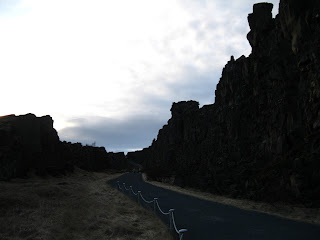"For from the plain on which they journeyed a large part had fallen clean away, many yards down, and it lay below like the bottom of a pan. The Great Rift was the name of the western precipice, and there was no way down save by one steep path....When Rolf had got down to the plain, he saw all the booths for the lodging of those who came to the Althing, ranged along the river....he went down to the Hill of Laws, where the Fifth Court sat to hear appeals. Now the Hill of Laws is cut off from the plain by deep rifts, and men showed Rolf where, to save his life, Flosi had leaped one rift at it's narrowest part and that was a great deed." -The Story of Rolf and the Viking Bow, page 94-95
 | |
| View from the plain above, overlooking Þingvellir |
The Great Rift (western precipice) is on the left side of the picture below. The flag pole is rising from the Lögberg (Law Rock) which either is the Hill of Laws, or a part of the Hill of Laws.
 | ||||||||||
| Down beside the precipice |
 | ||||
| The Great Rift. |
In the photo below, you see the view if you turn and look the other way up the rift while standing the Hill of Laws.
 | ||||
| The Rift |
 |
| Snorri's Booth |
 | ||
| Hill of Laws |
 | |||||
| The Rivers |
Above are the rivers by which the booths stood; the view from the Hill of Laws.
 | |||
| Þingvellir |
Allen French called this place, "that great wonder of Iceland." And it really is. The place is gorgeous, my pictures do not do it justice. In a sense it is the heart of Iceland, of both the land and the country.
It is near the place where the tectonic plates collide, the volcanic activity caused by this collision is possibly responsible for the formation of this island, and the fact that the land sits where two tectonic plates meet is responsible for the many geological wonders of this country: the volcanoes, geysers, and hot springs. Volcanoes have played a huge role in making Iceland the land it is today. Basalt is basically everywhere you turn. And other forms of volcanic rock are also abundant.
In this place so near the edges of the plates, the country was formalized. The Alþingi began in 930 A.D. and continued for many years and after an interlude of foreign control, Iceland was declared an independent republic in 1946. A ceremony was held at the Law Rock. From the start, Iceland was different from other nations. In 930, Europe was ruled by kings, yet Iceland was a republic. There were no kings or nobility. There were chieftains and some men had more power than others, but it was still different than the other countries of the the time.
All photos are my own.
No comments:
Post a Comment